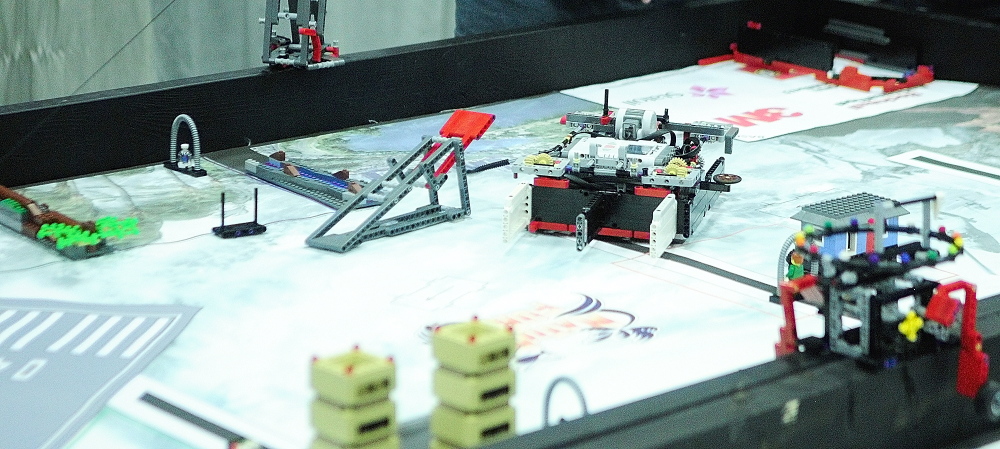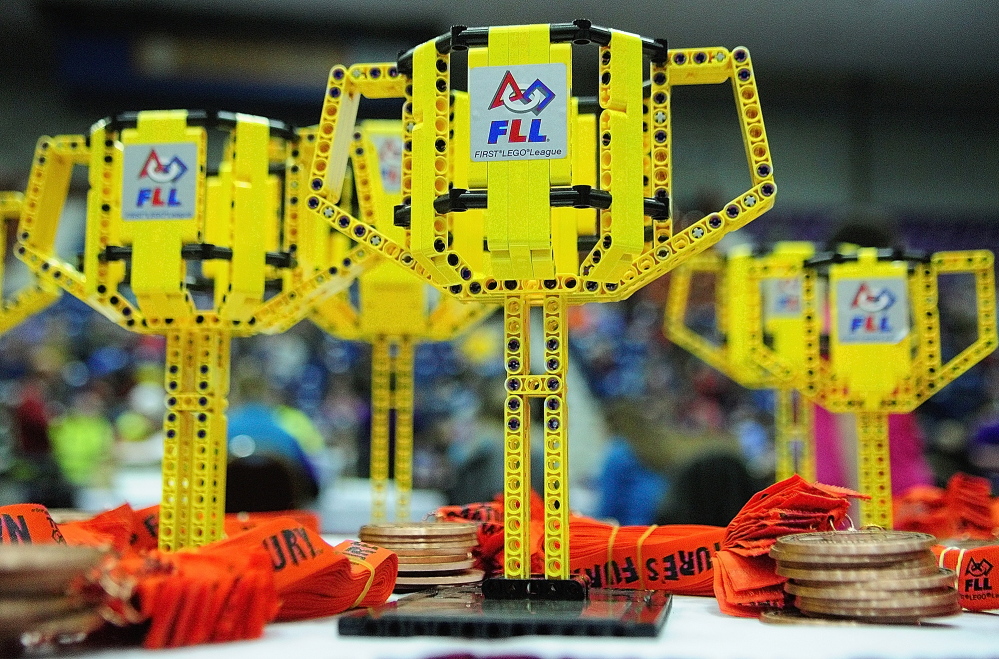AUGUSTA — Small robots traversed the 8-foot by 4-foot tsunami-torn scenes, delivering water to survivors, clearing airplane landing strips and reuniting pets with their owners.
For one of the missions – which proved to be the most challenging for the programmed Lego robots and their jerky movements – they had to push an evacuation sign upright before returning to base.
The disaster response missions played out on 12 game boards throughout the Maine FIRST Lego League Championship on Saturday at the Augusta Civic Center. About 550 kids in more than 60 teams from all over Maine competed in the competition. They were tasked with building and programming Lego robots to complete kinetic challenges on plywood disaster scenes, as well as identifying and providing a solution to a problem that could happen in a community during a natural disaster.
The worldwide competition is a partnership between the Lego Group and FIRST, a nonprofit organization that encourages students to explore science, technology, engineering and mathematical fields, the STEM areas, through a variety of robotics competitions. The annual Lego competition presents different real-life scientific challenges, such as the natural disaster topic this year.
Independent U.S. Sen. Angus King praised the participants during his welcoming remarks at the event, calling them “America’s secret sauce” for having the power to create things.
King said the winning team could come to Washington, D.C., for a tour of the capital and joked that they could help make things work down there.
“You represent the best of Maine. You represent the hope of this country. Have fun, build, make them work,” King said.
Halfway through the day, members of one of the leading teams in the robotics challenge, the Bridgineers of Farmington, gathered around a practice board for test runs with their robot. Their robot, looking somewhat like a Mars rover built with plastic block toys, struggled to lift the evacuation sign upright. In one of its last trial runs, it successfully pushed the sign up, but the robot knocked the sign over as it turned toward its home base.
The Lego robots aren’t remote controlled. Instead, the kids must write computer programs to control every movement of the robot.
For the Bridgineers, the students hoped the last-minute adjustments would allow them to finally perfect their robot’s final runs in their next match. During the match, the robot completed some missions, including saving the pets and moving the cargo plane and supply truck in position. However, it pushed the evacuation sign too hard, knocking it back down.
Christopher Marshall, a seventh-grader at Mount Blue Middle School, said the team targeted certain missions – there were 19 total – they deemed feasible in the 2½-minute round.
He said the seven team members met at coach Claire Andrews’ house two or three times a week since September. For the last two weeks, they met almost every day, Marshall said.
Many of the teams at the competition are school groups, but some, such as the Farmington team, aren’t organized through the school.
The other aspect of the competition is project-based. The kids need to present an innovative solution to a problem that could arise in a natural disaster. Andrews said they tried to solve the problem of unsafe bridges in rural, isolated areas.
The team, inspired by two flooding disasters that damaged bridges in their area in 1987 and 2011, designed a bridge safety system that lowers gates to block vehicles from going across if a proximity, waterline or vibration sensor is triggered.
In the more recent disaster in 2011, Tropical Storm Irene destroyed two bridges along Route 27 leading to Sugarloaf ski resort in Carrabassett Valley, temporarily stranding about 100 resort guests and employees.
Teams are required to keep their ideas grounded in real life. They’re judged partly on whether they considered the factors of implementation including costs and ease of manufacturing, and they’re encouraged to consult with experts in the fields as part of their research.
Paul Koenig can be contacted at 621-5663 or at:
pkoenig@centralmaine.com
Twitter: paul_koenig
Send questions/comments to the editors.



